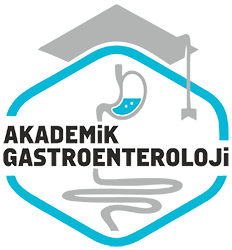Peptik ülser perforasyonu ve kronik obstruktif akciger hastalığı bulunan bir hastada: Pnömatozis sistoides intestinalis
Determination of perforated peptic ulcer and chronic obstructive pulmoner disease:
Pneumatosis cystoides intestinalis
- Ana Sayfa
- Sayılar
- Peptik ülser perforasyonu ve kronik obstruktif akciger hastalığı bulunan bir hastada: Pnömatozis sistoides intestinalis...
Özet
Pnömatozis sistoides intestinalis (PSI), barsak duvarinda submukozal ve/veya subserozal hava kistlerinin bulunmasi ile karakterize, nadir görülen bir hastalıktir. 56 yaşinda erkek hasta, yaklasik bir yıldir ataklar halinde şiddetlenen karın ağrısı, bulanti ve kusma şikayetleri ile klinigimize basvurdu. Fizik muayenenede peritoneal iritasyon bulgulari mevcuttu. Direkt karin grafisinde, sag diafragma altında serbest hava mevcuttu. Hasta acil sartlarda ameliyata alındı. yapılan incelemede; ileoçekal valvin 10 cm proksimalinde baslayip 170 cm’lik ince barsak segmentinin serozal yüzeyini kaplayan ve en büyügü yaklasik olarak 3 cm çapa ulasan çok sayida hava kesecikleri, sag diyafragma paryetal periton kisminda da multipl sayida hava kesecikleri olduğu görüldü. Piloroplasti hatti üzerinde 0,5 cm boyutunda kapali perforasyon alani olduğu görüldü ve primer olarak onarildi. Postoperatif dönemde hastaya kronik obstruktif akciger hastalığı (KOAH) tanısı konularak buna yönelik tedavi ve rehabilitasyon uygulandi. Sonuç olarak, acil Girişim gerektiren sekonder pnömatozis sistoides intestinalisli vakalarda postoperatif dönemde neden arastirilmali ve buna yönelik tedavi yapilmalidir.
Abstract
Pneumatosis cystoides intestinalis is a rarely seen disorder, characterized by multiple subserosal and/or submucosal gas-filled cysts in the bowel wall. A 56-year-old man with symptoms of attacks of nausea, vomiting, abdominal pain and distension for nearly one year was admitted to our department. In the physical examination, peritoneal irritation findings were present. Direct radiography demonstrated free intraperitoneal air under the right diaphragm. An emergency laparotomy was performed with the diagnosis of acute abdomen. During laparotomy, multiple gas bubbles were observed in the subserosa of the 170 cm ileal segment starting 10 cm proximal from the ileocecal valve, with the biggest cyst reaching 3 cm in diameter. Multiple gas bubbles were detected in the parietal peritoneum of the diaphragm’s right section. A perforation closed-hole with a diameter of 5 mm in the center of the pyloroplasty line was noticed and repaired primarily. Postoperatively, chronic obstructive pulmonary disease (COPD) was diagnosed and appropriate treatment and rehabilitation were applied. In conclusion, the reasons for secondary PCI cases, which require urgent operation, should be investigated carefully and the treatment should be done accordingly.



